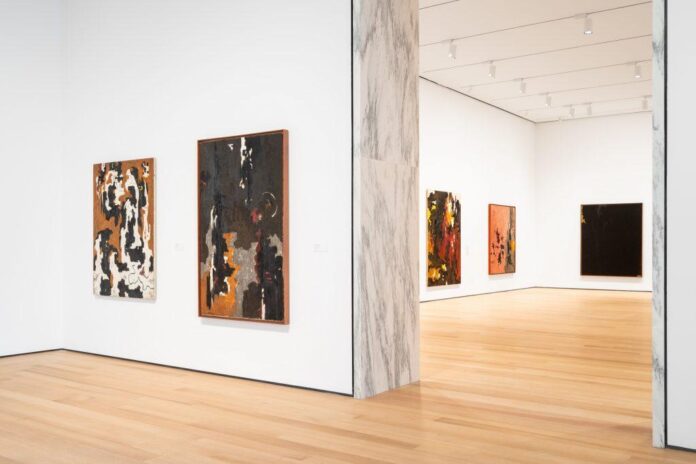What You Need to Know: In the 1950s, Abstract Expressionist painter Clyfford Still maintained a special relationship with the Buffalo AKG Art Museum, then known as the Albright Art Gallery. Following the institution’s acquisition of (1954) in 1957 Still became well acquainted with Director Gordon M. Smith and Board President Seymour H. Knox, Jr., the former of whom invited the artist to stage a large-scale survey exhibition, “Paintings by Clyfford Still,” of his work in 1959—which gave the Still unprecedented control over the show’s organization. The museum inducted yet another of Still’s paintings into its collection as a result, which led Still to recognize the institution as an apt venue for his work, and he ultimately donated 31 of his works in 1964. On view through February 19, 2023, Buffalo AKG Museum is presenting “Clyfford Still: A Legacy for Buffalo,” highlighting the special relationship between museum and artist. Included in the show are all 33 of the museum’s collection works by Still, as well as archival materials that document the unique affiliation. Following the exhibition, a selection of Still’s work will go on permanent view in a dedicated gallery.

Installation view of “Clyfford Still: A Legacy for Buffalo” (2023). Courtesy of Buffalo AKG Art Museum.
About the Artist: A seminal figure from the first generation of Abstract Expressionists, American artist Clyfford Still (1904–1980) is credited with helping build the foundation both for the movement as well as the move towards abstraction overall which occurred in the 20th century. Originally from North Dakota, Still studied at Spokane University and Washington State University, earning his MFA in 1935 and teaching at the school until 1941. Following his relocation to the San Francisco Bay Area in 1941, where his first solo exhibition was held in 1943 at the San Francisco Museum of Art, Still met fellow painter Mark Rothko, who introduced him to Peggy Guggenheim. Guggenheim staged a solo exhibition of Still’s work at her influential Art of This Century Gallery in 1946, and the following year the artist joined Betty Parsons Gallery. Still taught at the California School of Fine Arts for the latter half of the 1940s, before moving to New York City for the better part of the 1950s—at the height of Abstract Expressionism’s popularity. Ultimately, disillusioned with the art world, Still ceased working with commercial art galleries and moved to Maryland, where he lived and worked for the remainder of his life.

Installation view of “Clyfford Still: A Legacy for Buffalo” (2023). Courtesy of Buffalo AKG Art Museum.
Why We Like It: The influence of Still’s work and practice on the development of 20th-century art was monumental—and can still be felt today. The artist’s immense donation of paintings to the Buffalo AKG Museum offers a rare opportunity to experience his paintings as a collection rather than individually, a happening rivaled only by the exhibition of his work at the Clyfford Still Museum in Denver, Colorado, which was founded in 2011. Viewed together, the sequence of paintings illustrates the trajectory of Still’s painting practice and makes evident the formal qualities and tenets he engaged with throughout his career. Early paintings show the influence of Surrealism, and examples from his mature period are a testament to his achievement in total abstraction. Hung adjacent to the present exhibition is “Still’s Legacy and Influence,” comprised of a selection of works by artists influenced by or in dialogue with Still’s oeuvre, and include pieces by Joe Bradley, George Baselitz, and Richard Diebenkorn. Together, the Buffalo AKG Museum situates itself still, nearly 60 years after the initial donation, as a champion of the artist’s work and legacy.

Installation view of “Clyfford Still: A Legacy for Buffalo” (2023). Courtesy of Buffalo AKG Art Museum.

























